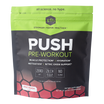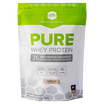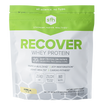Benefits You May Not Know About Running Sprints
Picture this: You’re on a camping trip with some friends. A bear approaches the camp. You and your friends find yourselves in a staring contest with a ferocious grizzly.
Your friend sitting next to you whispers, “I’m going to make a run for it…” You reply, “There’s no way you can outrun a bear.” To which your friend replies, “I don’t have to outrun the bear… I just need to outrun you!!!”
Sadly, you have not been running your sprints. RIP.
All jokes aside, sprinting is one of the most functional exercises you can do. You don’t need any special equipment, just a track, open field, or a hill. Sprinting is a fun, highly effective exercise and at some point in time you might need that the ability to quickly help someone, escape a bee, or even a grizzly bear (but please research proper bear protocol before running).
Here are 6 practical reasons you should be running sprints at least once per week:
1: Sprinting Builds Muscle
Jogging is still a great workout for improving your cardiovascular health, which directly translates to a stronger, healthier heart. But when you sprint, you get a lot of the same cardio benefits plus you use Type II muscle fibers! Type II muscle fibers, also known as “fast-twitch” muscles, are responsible for the powerful force exerted during a sprint, unlike the “slow-twitch,” Type I muscle fibers activated during jogging are responsible for less powerful forces but longer endurance. When Type II muscle fibers break down, they eventually rebuild with the right nutrition. Over time this helps to increase muscle mass in the legs.
2: Sprinting Might be the Best Ab Exercise
People always ask me how to get visible abs. When I say to them a calorie deficit and running sprints, they are disappointed. It might not be glamorous – but it’s true! When sprinting you must actively fight to keep your torso from twisting. So, for whatever distance you are sprinting, you are performing an anti-rotation ab exercise.
Sprinting helps burn fat (more on that in just a minute), which is crucial for uncovering those strong core muscles and making them more visible. Have you ever seen someone in a high level 100m dash that wasn’t ripped? Me either!
3: Sprinting Burns Fat
You can burn a lot of calories by running sprints, which aids in fat loss. In fact, some studies have found that sprinting is one of the most efficient calorie-burning workouts, more so even than high-intensity interval training (HIIT).
Since sprinting also allows you to gain muscle mass, over time this helps to increase your Basal Metabolic Rate, or the number of calories that your body needs to burn simply to maintain itself. This means that the muscle mass you gain can actually help you burn more calories throughout the day and even while you sleep!
4: Sprints are Time Efficient
Another major benefit that comes from sprinting is that you can burn a ton of calories and push yourself to your physical limits in a shorter amount of time than it would take to do a steady-state exercise like running. A 5 or 6-mile jog takes a lot of time for most people, probably an hour plus for most. Running 10-12 100-meter sprints, including a warm-up and cool-down, could be done in 20-30 minutes. Shorter duration and higher efficiency!
5: Sprinting Can Improve Your Mood
This might be one of my favorite benefits of any style of running. Running sprints will typically be done outdoors. We stare at our phones, tablets, and computers all day long, which studies have shown can be bad for both our sleep and our mental health. But when you get off the screens and instead spend time outdoors and out in nature, it’s proven to help reduce some of that psychological stress.
When outdoors, we also get Vitamin D from the sun. Vitamin D and sunlight might be the biggest natural mood boosters and have even been found to help reduce depressive symptoms in people who previously showed evidence of insufficient Vitamin D levels. Lastly, any type of exercise helps to release endorphins, which are brain chemicals that make us feel better physically and mentally – and the great news is that this is especially true in the case of higher-intensity workouts.
6: Sprints are Most Applicable to Sports
Most sports require short, quick bursts. In tennis, you have to sprint to the other side of the court to return the ball. In ultimate frisbee, you must sprint down the field to catch the disc. Basketball requires you to sprint up and down the court multiple times per game. If you want to increase your performance in literally any sport that requires quick bursts of energy, running sprints is a must.
How to start sprinting
There are so many more benefits of running sprints that didn’t make my top 6. Honorable mention benefits of sprinting include: improved bone density, improved cardiovascular health, better glucose control … and probably the most important, sprints are FUN!
So, you are convinced now, where do you go from here?!
Step 1: Start small
If it’s been a while since you have run sprints, don’t go full tilt on day one. Think about gradually increasing intensity over a few weeks. Mark off 100 meters and do 10 sprints at what you feel is about 70% of your max speed. The next week, build to 75%. Once you become acclimated to this style of training, each sprint will be full tilt!
Step 2: ALWAYS Warm-Up
Not warming-up before running sprints is asking for a pulled hamstring. A proper warm-up is all part of the workout and will help to avoid injuries. Before a dynamic workout you don’t want to do static stretching, you want to do dynamic movements to prepare your body. Try something like this:
- ¼ mile (400m) Jog
- Leg Swings
- Then march off 10 meters and do each exercise down and back:
- Butt Kicks, High Knees, High Knee Skip
Followed by 3-4 runs at your given distance for the day, start slow and gradually increase speed each rep.
Step 3: Stay Relaxed
If you tense up when sprinting, that’s when injury is more likely to occur. I was always taught that sprinting had to be “relaxed aggression.” Watch a video of Usain Bolt sprinting. His face is bouncing and expressionless.
Two Examples of Sprint Workouts:
Workout A:
- Warm-Up
- 4x100m “Build-Ups” (four 100m runs gradually increasing speed)
- 10x100m Sprint (sprint 100m as fast as you can with proper form, walk back slowly to start line for rest)
- Cool-Down
Workout B:
- Warm-Up
- 4x40yd “Build-Ups” (four 40yd runs gradually increasing speed)
- 20x40 yd Hill Sprints (sprint uphill 40yds as fast as you can with proper form, walk down slowly to start line for rest)
- Cool-Down
There you have it! You are ready to hit the track and take your fitness to the next level!
Meet the Author

Ben Barker is a fitness coach from Little Rock where he lives with his wife, 3 kids, and their dog, Wrigley. He graduated with a Bachelor of Science in Kinesiology from the University of Central Arkansas and is passionate about helping people push their boundaries of fitness and performance.

















